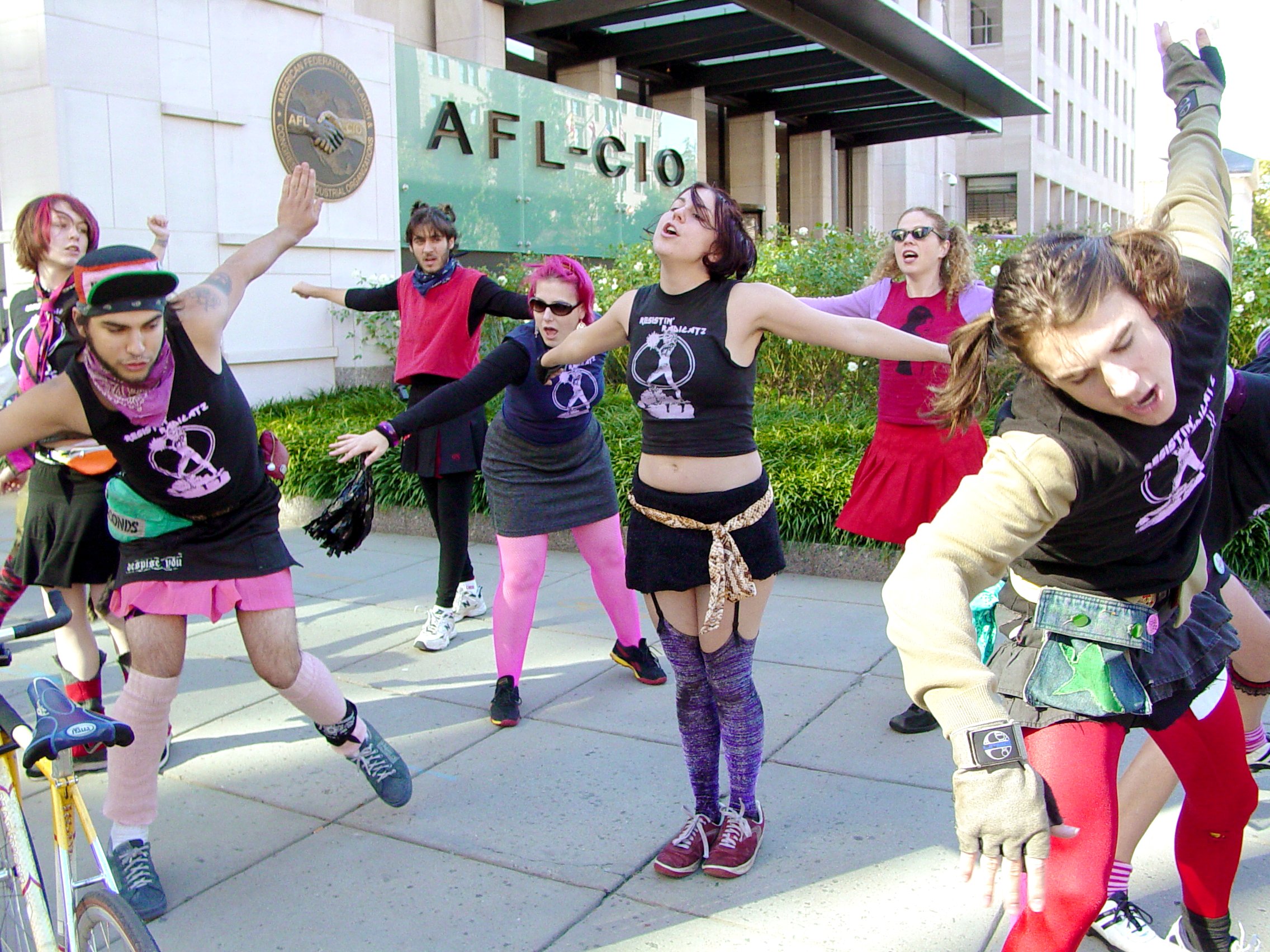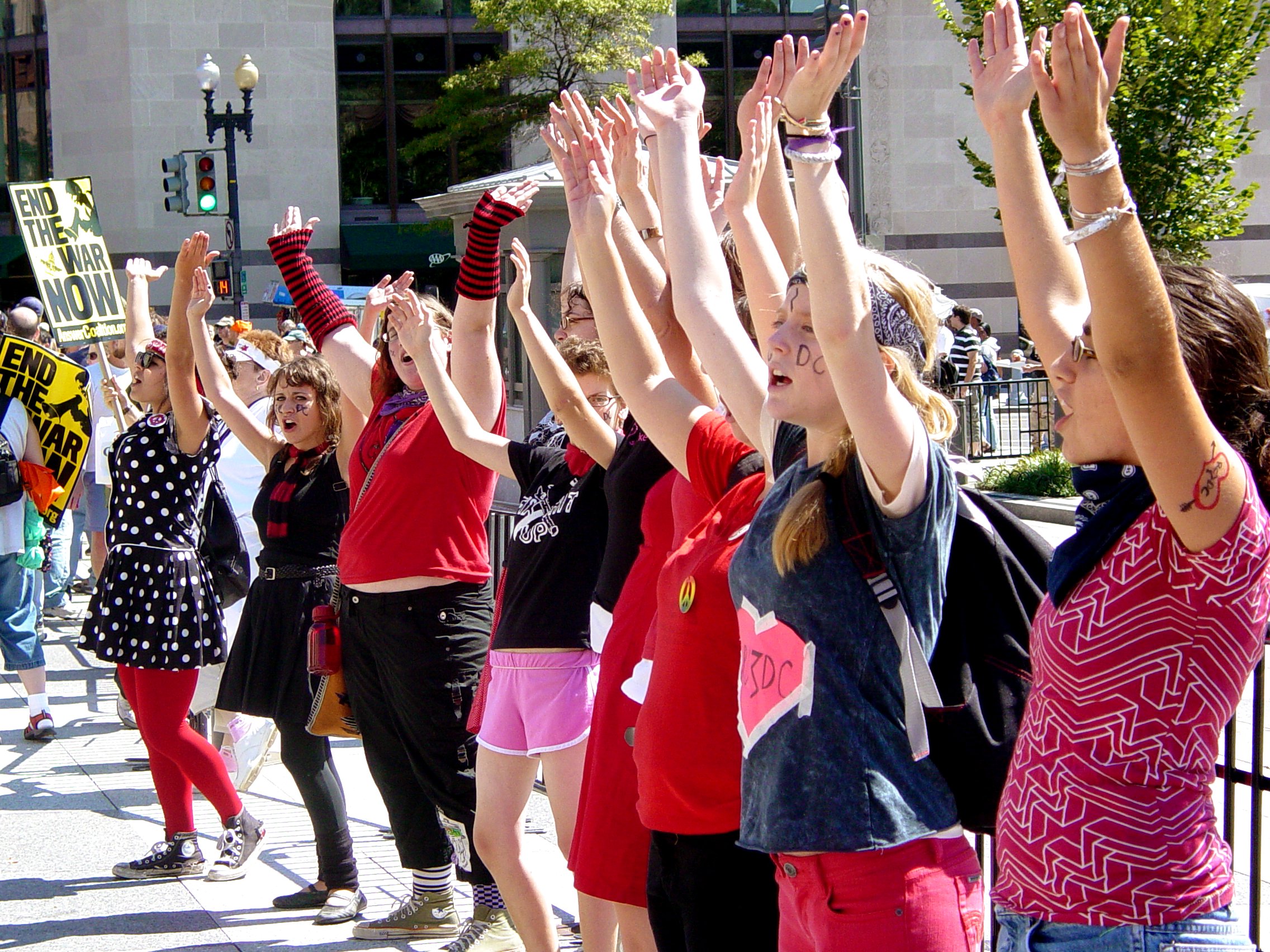Radical cheerleading on:
[Wikipedia]
[Google]
[Amazon]
 Radical cheerleading is a performative style of political activism, derived from mainstream
Radical cheerleading is a performative style of political activism, derived from mainstream

 Radical cheerleaders often perform at political
Radical cheerleaders often perform at political
 Radical cheerleading is a performative style of political activism, derived from mainstream
Radical cheerleading is a performative style of political activism, derived from mainstream cheerleading
Cheerleading is an activity in which the participants (called cheerleaders) cheer for their team as a form of encouragement. It can range from chanting slogans to intense physical activity. It can be performed to motivate sports teams, to ente ...
. Radical cheerleading combines elements of peaceful protest or non-violent direct action with theatrical elements including costuming, spectacle and choreographed dance. Radical cheerleading was created by sisters Cara Jennings, Aimee Jennings and Coleen Jennings in Miami, Florida, USA in 1996. It grew to become an international movement with squads in the United States
The United States of America (U.S.A. or USA), commonly known as the United States (U.S. or US) or America, is a country primarily located in North America. It consists of 50 states, a federal district, five major unincorporated territori ...
, Canada
Canada is a country in North America. Its ten provinces and three territories extend from the Atlantic Ocean to the Pacific Ocean and northward into the Arctic Ocean, covering over , making it the world's second-largest country by tot ...
and the European Union
The European Union (EU) is a supranational political and economic union of member states that are located primarily in Europe. The union has a total area of and an estimated total population of about 447million. The EU has often been de ...
. Radical cheerleaders create and adapt cheers that promote feminism
Feminism is a range of socio-political movements and ideologies that aim to define and establish the political, economic, personal, and social equality of the sexes. Feminism incorporates the position that society prioritizes the male po ...
and left-wing
Left-wing politics describes the range of political ideologies that support and seek to achieve social equality and egalitarianism, often in opposition to social hierarchy. Left-wing politics typically involve a concern for those in soci ...
ideals.
Subculture
Radical cheerleading developed as subculture apart fromcheerleading
Cheerleading is an activity in which the participants (called cheerleaders) cheer for their team as a form of encouragement. It can range from chanting slogans to intense physical activity. It can be performed to motivate sports teams, to ente ...
. Mainstream cheerleading reached new heights of popularity in the 1990s, as it transformed from a form of entertainment to being understood as an athletic sport. The first Cheerleading World Championship took place in 2001, asserting cheerleading as a competitive sport. During this time the popular view of cheerleaders in the United States was highly gendered and highly sexualized, including the Bring It On Bring It On may refer to:
Books
* ''Bring It On'' (book), by Pat Robertson
* ''Bring It On!'' (manhwa), a romance manhwa by Baek Hye-Kyung
Film and stage
* ''Bring It On'' (film series), an American series of teen comedy cheerleading films capit ...
franchise of films. The satirical practice of radical cheerleading developed alongside the growing popularity of cheerleading in popular culture. Author Christine Ro writes, "the popular image of cheerleading was still very much of the minimally dressed female cheerleader on the sidelines of a male sports event. This was the image radical cheerleaders seized upon in order to subvert gender messages while serving up peppy support for social justice causes."
Gender non-conformity
Gender non-conformity is a foundation upon which the subculture of radical cheerleading developed. Since its creation, radical cheerleading has been a movement open to all: participants may be male, female,transgender
A transgender (often abbreviated as trans) person is someone whose gender identity or gender expression does not correspond with their sex assigned at birth. Many transgender people experience dysphoria, which they seek to alleviate through ...
, non-binary
Non-binary and genderqueer are umbrella terms for gender identities that are not solely male or femaleidentities that are outside the gender binary. Non-binary identities fall under the transgender umbrella, since non-binary people typically ...
or non-gender identified. Often, radical cheerleaders subvert gender norms through costuming and aesthetics. According to author and radical cheerleader Jeanne Vaccaro, the movement was responsible for "cultivating a queer sensibility."

Aesthetics
Radical cheerleaders reappropriate the aesthetics of cheerleading, sometimes in an ironic fashion. Radical cheerleaders dress in diverse ways. Radical cheerleading is often marked by a DIY aesthetic, with handmade costumes and props. Some radical cheerleaders makepom-pom
A pom-pom – also spelled pom-pon, pompom or pompon – is a decorative ball or tuft of fibrous material.
The term may refer to large tufts used by cheerleaders, or a small, tighter ball attached to the top of a hat, also known as a ...
s using garbage bags by folding them in half, tying off one side with a rubber band and then cutting strips from the other end.
Every squad has a unique aesthetic of its own. The Dirty Southern Belles, from Memphis, Tennessee, wear the colors pink and black to cheer for gay pride. The Pirate Cheerleaders, a squad from Milwaukee, wear black skirts with white pleats, and shirts with pirate logos when performing at basement punk shows. The New Paltz Rads, a squad from the State University of New York at New Paltz, sport signature colors black and red.
Notable demonstrations
 Radical cheerleaders often perform at political
Radical cheerleaders often perform at political demonstrations
Demonstration may refer to:
* Demonstration (acting), part of the Brechtian approach to acting
* Demonstration (military), an attack or show of force on a front where a decision is not sought
* Demonstration (political), a political rally or prote ...
, festivals and other feminist events, where they lead protest chants. Radical cheerleading is used at demonstrations to promote political messages in a media-friendly, people-friendly way. Radical cheerleaders may also perform on stage at music venues, to bring political issues (as well as entertainment) to an unsuspecting crowd.
A notable demonstration took place at a Taco Bell restaurant in Auburn, Alabama in 2001, where radical cheerleaders gathered to protest for fair wages. Dubbed the "Taco Bell Protest," participants explained to police that the purpose of their demonstration was to protest the business relationship between corporate Taco Bell and the Six L's Packing Company, Inc., a firm that pays employees low wages with zero benefits.
Radical cheerleaders demonstrated at the 2004 Republican National Convention in New York, the March for Women's Lives in Washington, DC
)
, image_skyline =
, image_caption = Clockwise from top left: the Washington Monument and Lincoln Memorial on the National Mall, United States Capitol, Logan Circle, Jefferson Memorial, White House, Adams Morgan ...
on April 25, 2004 and The Resistin' Radicatz, a radical cheerleading squad, performed at the 2004 Million Worker March
The Million Worker March was a rally against perceived attacks upon working families in America and what organizers described as millions of jobs lost during the Bush administration with the complicity of the Congress of the United States.
The ...
.
Cheer content
Cheers are usually written from scratch or by rewriting the words of popular and historic songs. The first radical cheer book was published in 1997. An example of a radical cheer, led by creator Cara Jennings, performed at the 2004 Republican National Convention in New York: An example of a cheer performed by the Radical Teen Cheer Squad: "We're teens, we're cute, we're radical to boot! We're angry, we're tough, and we have had enough!"Media
In ''Give Me An F: Radical Cheerleading and Feminist Performance'', radical cheerleader and Author Jeanne Vaccaro describes the process of archiving radical cheerleading through the examination of cheers, zines, photographs and personal testimony from fellow radical cheerleader Mary Xmas. In a speech at the National Women's Studies Association in 2004, feminist magazine directorLisa Jervis Lisa or LISA may refer to:
People
People with the mononym
* Lisa Lisa (born 1967), American actress and lead singer of the Cult Jam
* Lisa (Japanese musician, born 1974), stylized "LISA", Japanese singer and producer
* Lisa Komine (born 1978), ...
placed radical cheerleading within a tradition of playful feminist comment on popular culture.
In August 2004 the New York City Radical Cheerleaders completed ''Don't Let the System Get You Down—Cheer Up'', a video documentary of the Radical Cheerblock at the March for Women's Lives. The video was released in time to celebrate and honor and inspire the hundreds of radical cheerleaders who converged in New York to protest the Republican National Convention.
Responses
Radical cheerleading is a style of performance, and is inherently defined by the element of spectacle. Responses within the media have ranged from positive to negative. Sheila Noone, the editorial director of ''American Cheerleader'' magazine, commented that cheerleaders are involved in an "uphill battle" towards gaining respect, asserting that radical cheerleading makes this even more difficult. In contrast, Lauren Jack, member of Harvard University's Cheerleading squad, made the statement that cheerleading is "all about trying to get everyone else excited about your causes, so it's perfect for political activism."See also
*Anarcha-feminism
Anarcha-feminism, also referred to as anarchist feminism, is a system of analysis which combines the principles and power analysis of anarchist theory with feminism. Anarcha-feminism closely resembles intersectional feminism. Anarcha-feminism ...
*The arts and politics A strong relationship between the arts and politics, particularly between various kinds of art and power, occurs across historical epochs and cultures. As they respond to contemporaneous events and politics, the arts take on political as well as ...
*Gender bender
A gender bender is a person who dresses up and acts like the opposite sex. Bending expected gender roles may also be called a genderfuck.
Gender bending may be political, stemming from the early identity politics movements of the 1960s and 19 ...
* Mary Christmas, one of the founding members of New York City's Radical Cheerleaders
*Politics and sports
Politics and sports or sports diplomacy describes the use of sport as a means to influence diplomatic, social, and political relations. Sports diplomacy may transcend cultural differences and bring people together.
The use of sports and politics ...
*Raging Grannies
The Raging Grannies (or just "Raging Grannies") are activist organizations in many cities and towns in Canada, the United States, and in other countries. The first group started in Victoria, British Columbia, Victoria, British Columbia, Canada, i ...
*Women's International League for Peace and Freedom
The Women's International League for Peace and Freedom (WILPF) is a non-profit non-governmental organization working "to bring together women of different political views and philosophical and religious backgrounds determined to study and make kno ...
References
External links
* {{Anarchism Anarcha-feminist collectives Activism by type ProtestsCheerleading
Cheerleading is an activity in which the participants (called cheerleaders) cheer for their team as a form of encouragement. It can range from chanting slogans to intense physical activity. It can be performed to motivate sports teams, to ente ...
Cheerleading
Anarchist theory
Feminism and the arts
Feminist protests